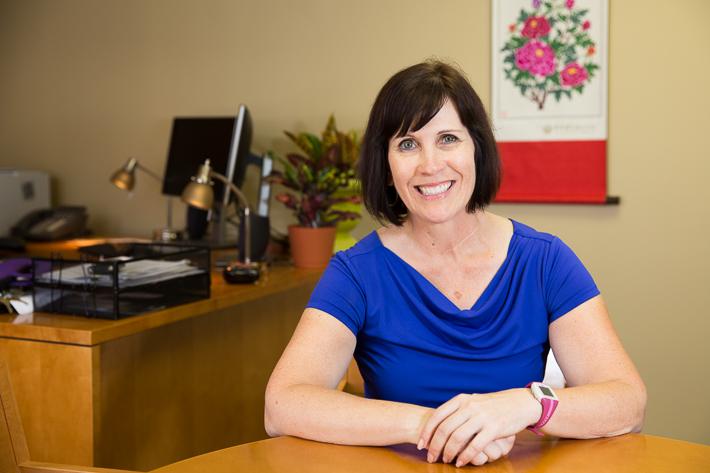Fabrication, falsification and plagiarism—they could threaten a researcher’s reputation and are in direct conflict with science’s truth-seeking mission. But as Sheila Garrity will tell you, “research misconduct is not black and white.”
The George Washington University welcomes Ms. Garrity as the new executive director of research integrity and compliance in the Office of the Vice President for Research. It is Ms. Garrity’s duty to ensure that GW upholds the highest standards of ethical research and scholarly conduct while pursuing its research mission. She has the responsibility of raising awareness about research misconduct policies and procedures as well as responding to allegations of misconduct.
Ms. Garrity came to GW in June after 23 years at Johns Hopkins University, where she served most recently as the director of research integrity in the School of Medicine’s Office of Policy Coordination. While at Johns Hopkins, Ms. Garrity held various positions while earning a law degree and a Master of Public Health degree.
George Washington Today sat down with the new executive director of research integrity and compliance to discuss her priorities as well as what she is looking forward to in her new role.
Q: What is research misconduct?
A: Research misconduct is defined as fabrication, falsification or plagiarism in the proposing, performing, reporting or reviewing of research or research results. Plagiarism is not just copying and pasting word-for-word. It’s the appropriation of someone’s ideas, thoughts or processes without appropriate credit. Fabrication is making up data or results so that the research is not accurately reported in the research record. Falsification could be dropping an outlier or changing data so that the research is not accurately reported.
Research misconduct is not black and white. It’s very gray. It is important to presume that the person accused is not responsible for misconduct until demonstrated otherwise. So when we receive an allegation, we must follow a process according to federal regulations. One of the educational outreach goals is to make sure the community is aware of what happens when we receive an allegation of misconduct and who to contact. GW has been fortunate in that it has not had many instances of research misconduct. But as the university continues to receive more research funding, the number of allegations could grow.
Q: What is the role of the executive director of research integrity and compliance?
A: I direct the offices of Human Research Subjects Protection, Animal Research, Laboratory and Biosafety and Regulatory Affairs. These offices work to support the university’s broad range of policies governing research activities to ensure we comply with our own policies as well as those government regulations applicable to research conducted at GW.
Q: What are your top priorities?
A: One of my first priorities is to inventory the current Responsible Conduct of Research activities at GW to make certain our community is well grounded in research ethics. In all of GW’s different schools, there must be a common denominator, no matter what type of research is being done. That common denominator is research ethics and the Responsible Conduct of Research. There is no need to reinvent the wheel if there are programs in place. It is however, important to take a look at those programs and have the information available in one place to better serve our research community.
Compliance is not really a term that I choose to use when I describe what I do. When I was hired, it was important to me that “integrity” was in the title and that it was listed first. Faculty and the community could look at the word “compliance” as a police function. I want to partner with our faculty and community to ensure that we are meeting the federal, state and local requirements as well as the standards of the Responsible Conduct of Research as part of GW’s mission. No one objects to the phrase, “research integrity.” Nobody wants to conduct sloppy research. It’s much better to partner with our community than to police them.
Q: What is your professional background?
A: I came to Johns Hopkins in 1991 when my husband was doing a post-doctoral fellowship at the university. Initially we were only going to stay for a few years, but 23 years later—after finishing a law degree and an M.P.H., all while working full time—I found a job that seemed to use all of those skills and allowed me to remain in academia. And that was in the field of research integrity and research compliance.
Q: What brought you to GW?
A: I met Associate Vice President for Research Jennifer Wisdom at a professional conference and learned about this opportunity at GW. At first, after being at Hopkins for 23 years, I could not even think of leaving. It was family to me. But I was still intrigued. I came to D.C. and spent a day talking to Vice President for Research Leo Chalupa and other university leaders. Everyone was so welcoming and so enthusiastic.
I remember Provost Steve Lerman said to me, “I was a lifer at MIT. And I never could have imagined leaving. I like to think I made a difference there, and I’m sure you made a difference at Hopkins. But I can tell you for sure, if you come to GW, you’ll make a difference.” That just stuck with me. By the end of the day, I said, “You know what, I think this would be really fun.”
Q: What excites you about GW and your new position?
A: GW has passionate people, and there is desire and movement to bring GW to the next level of research institutions. I want to help build the infrastructure that is required to do that in a responsible and thoughtful fashion. We can’t bring in more research programs without having the foundation to support them.


